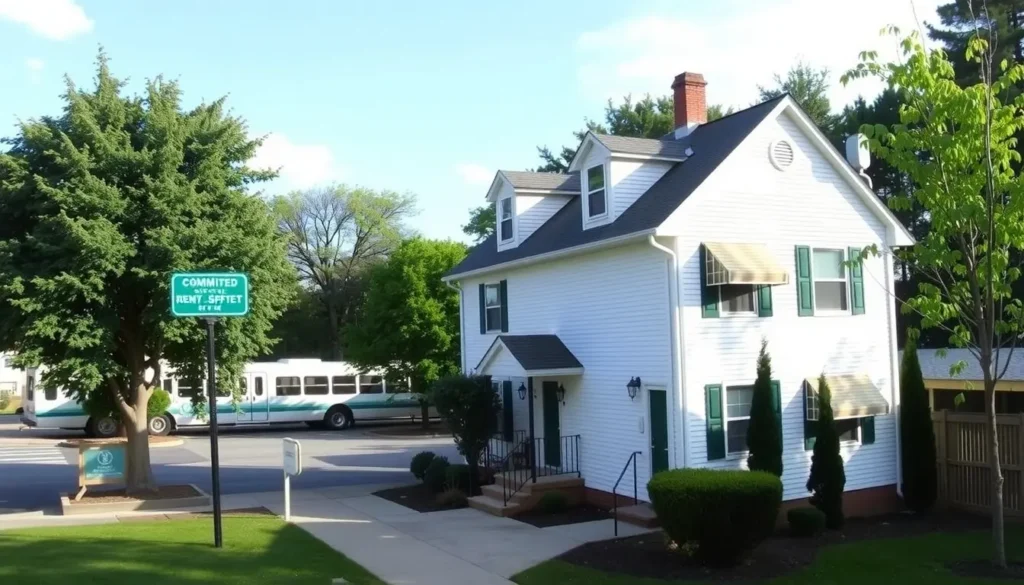1. Introduction: Is Bloomfield, NJ a Smart Rental Investment?
Real estate investing can be one of the most rewarding ways to generate passive income and build long-term wealth — but success depends heavily on choosing the right location. Bloomfield, NJ, has become increasingly popular with real estate investors due to its affordability, location, and potential for steady rental income. Located just 13 miles from Manhattan and offering easy access to major transit lines, Bloomfield attracts both young professionals and families looking for convenient, budget-friendly living.
But before diving into a purchase, investors must ask: Is this a profitable rental property? Understanding the dynamics of the local market is key. Whether you’re a seasoned investor or buying your first rental property, this guide will help you determine if a rental investment in Bloomfield, NJ is truly worth it — using data, strategy, and proven metrics.
We’ll break down essential tools like rental yield, cap rate, the 1% rule, local tenant demand, and legal factors specific to New Jersey. Read on to learn exactly what makes a Bloomfield property a good (or bad) investment — and how to identify the best opportunities.
2. Understanding Bloomfield’s Real Estate Market
Located in Essex County, Bloomfield is a mid-sized town known for its walkable neighborhoods, reliable public transportation, and proximity to Montclair and Newark. The town features a diverse mix of residential options — from charming colonial homes and duplexes to mid-size apartment buildings — making it ideal for different investor strategies.
According to Realtor.com, as of 2024 the median home price in Bloomfield is approximately $425,000, which is lower than the Essex County average. This price point appeals to both investors seeking lower entry costs and tenants searching for affordable rent near NYC. Meanwhile, rental demand remains strong, thanks to the influx of renters priced out of nearby towns like Montclair or Hoboken.
Rental inventory is tight — which benefits landlords. Listings rarely sit long on the market, and competition among tenants means less vacancy and higher monthly rents. Neighborhoods around Bloomfield Center and the Watsessing area are particularly attractive due to revitalization efforts and easy rail access to New York Penn Station.
3. Key Metrics to Evaluate Rental Property Investments
Before buying any investment property, especially in Bloomfield, it’s essential to evaluate the property using specific financial indicators. These will help you understand whether the rental will yield positive cash flow and long-term growth. Here are the most important metrics:
- Cap Rate: This measures the property’s potential return based on net income before financing. In Bloomfield, a cap rate between 5%–7% is considered competitive for residential rentals.
- Cash-on-Cash Return: This evaluates the annual return on the cash you’ve actually invested (including down payment and closing costs). It helps measure your return based on the leverage used.
- Net Operating Income (NOI): NOI is your gross rental income minus operating expenses (not including mortgage). This helps you compare properties apples-to-apples.
- Price-to-Rent Ratio: This ratio tells you how expensive it is to buy property compared to how much rent you can earn. We’ll break this down next.
These metrics aren’t just for spreadsheet analysis — they’re essential to avoid emotional or rushed decisions and to compare multiple opportunities within Bloomfield objectively.
4. Analyzing Rental Yields and Cap Rates in Bloomfield
Rental yield and cap rate are two of the most powerful tools for evaluating rental income performance in a specific market. In Bloomfield, average rents for a two-bedroom apartment range from $1,900 to $2,400 per month, depending on the neighborhood and unit quality. That translates to an annual gross rent between $22,800 and $28,800.
Let’s say you purchase a duplex in Brookdale for $400,000. After expenses and taxes, your NOI might be around $24,000. That gives you a cap rate of 6% — right within the target range. Properties closer to Bloomfield College or NJ Transit stations often command higher rents, boosting your yield further.
In areas undergoing revitalization or redevelopment, such as near the Bloomfield Green redevelopment zone, you might find even better returns. Investors willing to make minor upgrades or cosmetic renovations can often add instant value, raising rents and equity simultaneously.
Comparatively, cap rates in NYC can dip below 3%, so many investors look to towns like Bloomfield for higher returns without sacrificing rental demand.
5. Price-to-Rent Ratio: What It Reveals About Bloomfield
The price-to-rent ratio helps determine whether it’s more financially favorable to rent or buy in a given market. It’s a simple formula: divide the median home price by the average annual rent. In Bloomfield, we’ll use:
- Median Home Price: $425,000
- Median Monthly Rent: $2,200
- Annual Rent: $26,400
Price-to-Rent Ratio = $425,000 / $26,400 = 16.0
This ratio suggests a balanced market — not skewed too far toward renting or buying. Anything under 15 often indicates strong investor opportunity, while over 20 may indicate housing is overpriced relative to rent. At 16, Bloomfield shows healthy investment potential, especially if rents continue to rise as projected.
Additionally, with rent increases outpacing mortgage interest rates in recent years, this ratio makes Bloomfield especially appealing for buy-and-hold investors looking for cash flow now and appreciation over time.
6. Vacancy Rates and Tenant Demand in Bloomfield
One of the most overlooked but crucial aspects of analyzing rental property performance is the vacancy rate. In Bloomfield, NJ, the vacancy rate has consistently remained below the national average, hovering around 4–5% in recent years. This indicates a stable demand for rental housing — a strong sign for investors.
The demand is largely driven by young professionals, college students from nearby institutions, and commuters working in Manhattan or Newark. Transit-accessible neighborhoods like Bloomfield Center and Watsessing Avenue are especially popular among renters. As a result, landlords in these zones experience shorter turnover cycles and fewer unoccupied months.
To further reduce vacancy and tenant loss, it’s wise to invest in maintenance and tenant satisfaction strategies. You can explore methods for tenant retention here.
7. Property Appreciation Trends in Bloomfield
Beyond rental income, one of the most profitable aspects of owning investment property is appreciation — the rise in property value over time. According to Zillow home value data, Bloomfield properties have seen a steady appreciation rate of approximately 5–7% per year since 2019, outperforming several nearby markets.
This trend is fueled by multiple factors:
- Ongoing downtown revitalization projects
- Growing population of NYC commuters seeking affordable housing
- Limited housing inventory keeping demand high
Investors purchasing in gentrifying areas or near commercial developments are especially likely to see capital gains over time. Renovation-focused investors can also increase a property’s market value by implementing simple, budget-friendly upgrades.
8. The 1% Rule: Applying It to Bloomfield Properties
The “1% Rule” is a quick and popular rule of thumb used by real estate investors to evaluate whether a rental property will generate positive cash flow. It states that the monthly rent should be at least 1% of the property’s purchase price.
Example: If a Bloomfield duplex costs $375,000, it should ideally rent for $3,750 per month to pass the 1% rule. While this is a high benchmark, some properties — particularly multifamily units or renovated homes near transit lines — can come close to it, especially if bought below market value.
If a property meets the 0.8%–1.0% threshold and still delivers solid appreciation and low vacancy, it can still be a strong investment. The key is to evaluate cash flow in combination with tax benefits, appreciation potential, and financing structure.
9. Gross Rent Multiplier (GRM) and Its Significance
Another way to quickly assess investment potential is by using the Gross Rent Multiplier (GRM). This metric compares the property’s price to its annual gross rental income. Lower GRMs typically indicate better value for investors.
GRM Formula: Property Price ÷ Annual Rent Income
Let’s say you find a triplex in Bloomfield priced at $525,000, and you can rent each unit for $1,800/month ($5,400/month total or $64,800/year). The GRM would be:
$525,000 ÷ $64,800 = 8.1
A GRM between 6 and 10 is considered favorable in most suburban rental markets, making this a viable deal — especially if operating costs are well-managed. Learn more about keeping expenses under control in our guide to managing rental property expenses.
10. Financing Options for Rental Properties in Bloomfield
Securing the right financing can make or break the profitability of your investment. In Bloomfield, rental property buyers typically explore the following financing options:
- Conventional Loans: Often require 20–25% down but offer competitive interest rates.
- FHA Loans: Can be used if you plan to occupy one unit of a multi-family home (e.g., live-in duplex).
- DSCR Loans: These are for real estate investors and are based on the income the property generates rather than the investor’s personal income.
- HELOCs or Cash-Out Refi: Good for investors leveraging equity from existing properties.
Before choosing a lender, it’s essential to calculate how financing affects your cash flow. Consider using tools to forecast mortgage payments and compare them with projected rental income. For a smooth experience, many landlords partner with professional services — as explored in this guide to property management benefits.
11. Legal Considerations and Landlord-Tenant Laws in NJ
Investing in rental property isn’t just about numbers — it’s also about legal compliance. New Jersey, and by extension Bloomfield, has some of the most tenant-friendly laws in the country. As an investor, understanding these laws is critical to avoid costly lawsuits and delays in eviction proceedings.
For example, you must comply with regulations around:
- Security deposits (limited to 1.5 months’ rent)
- Notice requirements before raising rent or terminating tenancy
- Habitability standards (heat, water, pest control)
- Eviction laws and due process timelines
Failure to follow New Jersey’s strict rules can lead to delays in eviction, even if rent hasn’t been paid. We recommend reading our full New Jersey eviction guide for landlords and lease termination rules in NJ.
Working with a local property manager or landlord attorney can help you stay on the right side of the law — especially as state legislation evolves frequently. For a deeper overview of landlord legal duties, explore this legal responsibility guide.
12. Property Management: DIY vs. Hiring Professionals
Managing rental property in Bloomfield requires time, systems, and strong tenant relationships. Many new investors start by self-managing but quickly realize the value of hiring professionals. So should you go DIY, or should you work with a property management company?
Doing It Yourself gives you full control and saves on monthly management fees (typically 8–10%). However, it also means handling:
- Tenant screening and placement
- Rent collection and late payments
- 24/7 maintenance calls
- Legal notices, evictions, and lease renewals
If you’re not local or have a full-time job, this can quickly become overwhelming. In contrast, professional property management services can offer peace of mind, especially for out-of-state investors or those scaling their portfolio.
By outsourcing, you gain access to established vendor networks, proactive maintenance systems, and strategies to improve tenant retention. It’s an investment in long-term profitability and sanity.
13. Tax Implications and Benefits for Rental Investors
One of the biggest hidden advantages of real estate investing is the range of tax benefits available. Bloomfield rental property owners can legally offset many of their income streams through deductions, depreciation, and deferrals.
Here’s what you can typically write off as a landlord:
- Mortgage interest and loan fees
- Property taxes
- Repairs and maintenance
- Depreciation (building value over 27.5 years)
- Travel and home office expenses
- Professional services (accountants, attorneys, property managers)
Additionally, savvy investors may use a 1031 Exchange to defer capital gains tax when selling one property and purchasing another. That’s one reason real estate is considered one of the most tax-advantaged asset classes in the U.S.
Be sure to work with a tax professional who understands investment property rules. They can help you claim maximum deductions while staying compliant. You can also check out our article on managing expenses for better returns.
14. Common Pitfalls to Avoid When Investing in Bloomfield
Like any market, Bloomfield has its share of challenges that can trip up both new and experienced investors. Recognizing these pitfalls early can help you avoid financial losses and legal issues.
Top mistakes to avoid:
- Overpaying for property: Always analyze comps, rental data, and future appreciation trends before bidding.
- Underestimating repairs: Hidden costs can turn a great deal into a cash drain. Always inspect thoroughly.
- Weak tenant screening: Problem tenants are costly. Run credit checks, verify income, and require solid references.
- Ignoring vacancy risks: Even in high-demand areas, not marketing aggressively or pricing competitively can result in empty units.
For a full list of what not to do as a landlord, read our guide on avoiding costly mistakes. It’s a must-read for first-time investors or anyone managing their own rentals.
15. Case Studies: Successful Rental Investments in Bloomfield
Nothing illustrates a strong market better than real-world success stories. Here are a few fictional but realistic case studies based on actual trends observed in the Bloomfield area:
🏠 Case Study 1: Turnkey Duplex Near NJ Transit
A local investor purchased a duplex near Watsessing Avenue Station for $390,000. After light cosmetic updates totaling $18,000, the property was rented for $2,000 per unit — generating $4,000/month. With annual rent at $48,000 and operating costs at $12,000, the investor netted a 9.2% cash-on-cash return in year one.
🏠 Case Study 2: Section 8 Tenant Strategy
An investor secured a 3-bedroom single-family home and enrolled it in the Section 8 housing program. Guaranteed rental income, reduced vacancy risk, and a consistent payment structure led to steady cash flow. Explore our guide to Section 8 housing in NJ for more details.
🏠 Case Study 3: Out-of-State Investor With Property Management
A California-based investor bought a triplex in the Bloomfield Center area and hired a local property management company. The manager handled everything from tenant screening to repairs. Within 60 days, all units were rented, and the investor earned passive income with minimal involvement — a textbook example of successful remote ownership.






